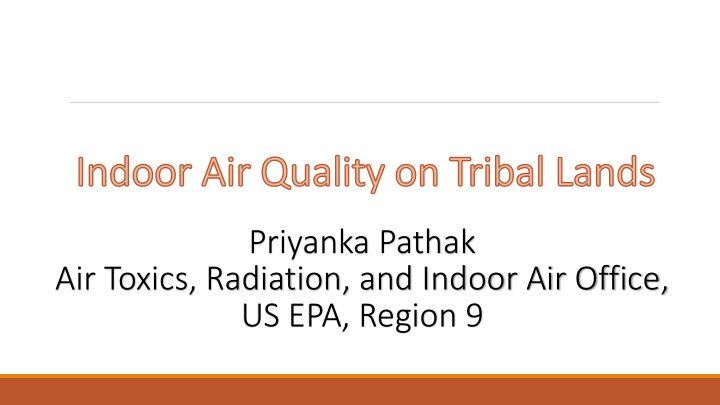



Priyanka Pathak Air Toxics, Radiation, and Indoor Air Office, US EPA, Region 9
Indoor Air Quality ( IAQ) on Tribal Lands Regional Tribal Operations Committee, Fall 2014 Presenter: Priyanka Pathak Air Toxics, Radiation, and Indoor Air Office, US EPA, Region 9 October 14, 2014 Sacramento, CA
Indoor Air Quality (IAQ) on Tribal Lands EPA Region 9 Air Toxics, Radiation, and IAQ & Health Indoor Air Office (ATRIA) & ATRIA Goals Activities & Partners IAQ Opportunities
IAQ and Health EPA’s Mission Environment Health IAQ: Opportunity to directly address environmental exposures to make an immediate positive impact on health outcomes.
IAQ and Health Air pollution can be many times more concentrated indoors compared to the than the outdoors. Sensitive groups • Children CHILDREN • • Elders Breathe more than adults, relative to their body weight • Those suffering • Children are rapidly growing and developing • Less developed natural defenses from heart and • Spend more time close to the floor, where lung disease contaminant levels can be higher • Those with certain genetic conditions
IAQ and Health RADON EXPOSURE PREVENTION • #1 cause of lung cancer among non-smokers • #2 cause of lung cancer overall (smoking is #1). • Responsible for about 21,000 lung cancer deaths every year. • Lung cancer risk is higher for radon-exposed people who smoke, and AI/AN have highest prevalence of smoking (21.8%) Most radon exposure occurs in the home. Testing for radon is inexpensive and easy. Homes with high radon CAN be fixed.
IAQ and Health MOLD Health Effects • Allergies • Respiratory symptoms • Asthma • Dampness and Mold in homes accounts for 20% of current asthma in the US, at an estimated You don ’ t have to test to know annual treatment cost of you have a problem and what to $3.5 billion (Mudarri and do about it! Fisk 2007). There is no practical way to eliminate all mold and mold spores in the indoor environment; the way to control indoor mold growth is to control moisture. For resources, visit: http://www.epa.gov/mold/
IAQ and Health ASTHMA Disparities • Asthma is the most common chronic childhood disease affecting 1 in 13 school aged children on average. • One of the leading causes of school absenteeism • 13.0% of American Indian/Alaska Native children compared to 8.9% of children in the U.S. TRIGGER MANAGEMENT In homes: In schools: Home-based multi-trigger Available Resources environmental interventions are • EPA Indoor Air Quality Tools for effective in reducing symptoms, school Schools Program and Action Kit days missed, and healthcare visits. • Trainings
Air Toxics, Radiation, and Indoor Air Office (ATRIA) Topic Areas Program Goals • Radon, • GAP & Air Grants • Radiation • • Support Tribal IAQ programs Mold • Ventilation • Tribal Indoor Air & Health • Wood & Coal Network Stoves • Asthma Trigger Management IAQ Accomplishments 2013-2014 • Community Air • Trainings: Toxics asthma triggers, • IAQ, mold Near-roadway • Pollution Navajo Nation Radon Program • IAQ in Schools • Navajo Nation outreach and Homes & PSAs on wood & coal • IAQ Guidance smoke (www.epapsa.com) (e.g. Tribal Green Building Toolkit)
Air Toxics, Radiation, and Indoor Air Office (ATRIA) Current Activities • Tribal IAQ programs • Research development • Trainings • Resource development & Guidance Partners/Collaborators • Diné College • Inter Tribal Council of Arizona (ITCA) • Northern Arizona University • Intertribal Council of Nevada – Institute for Tribal • National Indian Child Care Environmental Professionals (ITEP) Association – Arizona American Indian Asthma • Tribal Child Care Association of Coalition California – Tribal Air Monitoring System Center (TAMS) • University of Montana, Missoula • University of Tulsa
IAQ Opportunities: Clean Air Act Funding • Bishop Paiute Tribe Air quality specialist conducts individually-tailored air quality assessments in homes and tribally operated buildings (e.g. business, Head Start) and provides specialized IAQ reports on as- needed basis. Assessments lead to remedial actions. • Manzanita Band of Dieguengo Mission Indians Indoor air monitoring & education – monitor homes and offices for PM, provide Healthy Homes education and outreach to community, train their staff on IAQ, and identify health-based hotspots. • Morongo Band of Mission Indians Determines IAQ problems, implements strategy for problems, conducts community outreach, continues Tools for Schools • Tohono O'odham Nation Maintains a partnership with Institute for Tribal Environmental Professionals (ITEP) to do several yearly indoor air quality assessments at tribal schools. • Yurok Tribe Education and outreach – distribution of educational materials regarding indoor air quality health guidelines in newsletters and other quarterly mailers. Tribal Indoor Air Quality Programs in the Spotlight http://www.epa.gov/iaqtribal/spotlight.html
IAQ Opportunities: General Assistance Program (GAP) Funding Building Tribal Ambient and Indoor Air Quality Program Capacities • Section C.2 & C.3 in Appendix 1 of the Indian Environmental General Assistance Program Guidebook • Establishing Tribal Air Quality Programs ( C.2) Example activities: – Skill development: training staff – Compiling data – Community engagement • Indicators of Air Quality Program Capacity ( C.3) – Indoor air quality assessments and reporting – Establishing a radon program – Report recommending actions on indoor pollutants Tribal Indoor Air Quality Programs in the Spotlight http://www.epa.gov/iaqtribal/spotlight.html
How we can support your work? • Developing IAQ Team Contact Information: – Resources Priyanka Pathak pathak.priyanka@epa.gov – Partnerships Phone: 415-972-3576 – IAQ program strategy Shelly Rosenblum Rosenblum.Shelly@epa.gov • Capacity Building 415-947-4193 – Provide Trainings Katie Stewart – Air and GAP grants Stewart.Kathleen@epa.gov Phone: 415-947-4119 • Tribal IAQ & Health Network Monique Nivolon Nivolon.Monique@epa.gov Phone: 415-947-4195
Recommend
More recommend